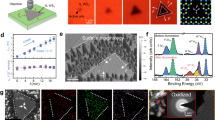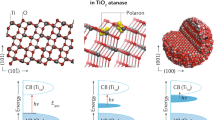Abstract
IT is well known that a space charge region is usually present in semiconducting oxides at metal-semiconductor junctions due to equalizing of Fermi levels at the junction1. Uhlig2 has pointed out that this space charge layer may be a determining factor for growth rate and for growth law. Specifically, Uhlig proposes that the space charge layer limits the flow of electrons (and thus the flow of ions) from metal to oxide, so the variation of the space charge layer characteristics with film thickness determines the growth law. The purpose of this communication is to point out some basic errors in the treatment of the model so that further development of this approach, as well as comparison with new experimental results, can be fruitful.
This is a preview of subscription content, access via your institution
Access options
Subscribe to this journal
Receive 51 print issues and online access
$199.00 per year
only $3.90 per issue
Buy this article
- Purchase on Springer Link
- Instant access to full article PDF
Prices may be subject to local taxes which are calculated during checkout
Similar content being viewed by others
References
Jordon, A. G., Lade, R. W., and Scharfetter, D. L., Amer. J. Phys., 31, 490 (1963).
Uhlig, H. H., Acta Met., 4, 541, 547, 544, 548, 552 (1956).
Fromhold, jun., A. T., J. Chem. Phys., 38, 282 (1963).
Author information
Authors and Affiliations
Rights and permissions
About this article
Cite this article
FROMHOLD, A. Uhlig Model of Oxidation Kinetics. Nature 200, 1309–1310 (1963). https://doi.org/10.1038/2001309a0
Issue Date:
DOI: https://doi.org/10.1038/2001309a0
This article is cited by
-
?Logarithmic? kinetics in thin film tarnishing
Oxidation of Metals (1972)
Comments
By submitting a comment you agree to abide by our Terms and Community Guidelines. If you find something abusive or that does not comply with our terms or guidelines please flag it as inappropriate.



